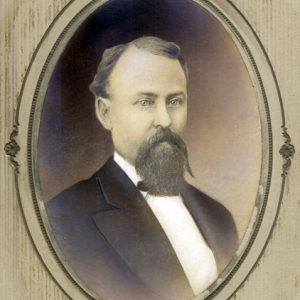calsfoundation@cals.org
John Newton Sarber (1837–1905)
John Newton Sarber was a Union soldier who remained in Arkansas after the Civil War and served in the state Senate, where he introduced a number of influential bills, including those creating the public school system and what is now the University of Arkansas (UA) in Fayetteville (Washington County). He also served as U.S. marshal of the U.S. Western District Court at Fort Smith (Sebastian County). Logan County was originally named Sarber County in his honor.
John Newton Sarber was born on October 28, 1837, in Pittsburgh, Pennsylvania, to Stephen and Lucille Sarber; he had one brother and two sisters. His mother died giving birth in 1849. The abolitionist family moved to Kansas Territory in 1855. Sarber and his father became involved with the newly formed Republican Party as soon as they arrived in Kansas. At the beginning of the Civil War, Sarber immediately enlisted as a private in the Second Kansas Infantry. He ultimately served as a standing orderly to Colonel Cloud of the 2nd Kansas Cavalry and later the 15th Kansas Cavalry. Sarber fought in the Battles of Old Fort Wayne (just across the state line in Indian Territory), as well as the Battle of Prairie Grove, the Engagement at Cane Hill, and the Action at Devil’s Backbone. At the close of the Civil War, Sarber remained in Arkansas and practiced law in Clarksville (Johnson County). On December 5, 1867, he married Susan Rebecca Rose, the daughter of Moreau Rose, early pioneer and a Confederate supporter; they had six children, five of whom lived to adulthood.
Sarber became a member of the constitutional convention of 1868, and he was afterward elected state senator from the Sixth District representing Johnson, Newton, and Yell counties. He served as president pro tempore for the first six weeks of the session. While in the state Senate, he introduced the bill that became Act 13 of 1869, which created the public school system in Arkansas. In addition, he introduced the bill that became Act 44 of 1871, creating Arkansas Industrial University (now UA). Sarber served on the university’s first board of trustees as well as on the committee that selected the design of Old Main, the first permanent building on the campus.
There was a great deal of pressure among the citizens of Johnson County to move the county seat back to its original site at Spadra Bluff, which was a river port. Such a move would likely lead to a decline of the city of Clarksville. In order to keep the county seat at Clarksville, Sarber introduced the bill that became Act 25 of 1871, which created a new county south of the Arkansas River. In 1871, the state legislature took that part of Johnson County south of the Arkansas River and combined it with part of Scott, Yell, and Pope counties; later they added part of Franklin County. Over his objections, the legislature named the county Sarber in his honor. The county retained that name from March 1871 until December 31, 1875. After the Democrats regained control of the Arkansas General Assembly, they renamed the county Logan, in honor of Colonel James Logan, a slaveholding pioneer of the region.
President Ulysses S. Grant, on March 17, 1873, nominated Sarber to fill the vacant post as U.S. marshal of the U.S. Western District Court at Fort Smith. The U.S. Senate confirmed Sarber’s nomination the next day. The office of marshal and the U.S. court in Fort Smith had been in a state of disarray for several years. Sarber had the dubious distinction of overseeing the first hanging at the newly constructed gallows in Fort Smith.
While he served as marshal, all letters from the U.S. attorney general addressed him as General Sarber. Sarber never rose above the rank of private, but various history books have perpetuated the mistake of calling him “General Sarber.”
Sarber, along with several other “carpetbaggers,” were charged with criminal acts related to the disbursement of funds from the marshal’s office. The charges were politically motivated. Sarber was never indicted, but under growing political pressure, he resigned as marshal on June 27, 1874, while he was in Washington DC.
Sarber’s commitment to the Republican Party, along with his loyalty to Governor Powell Clayton and President Grant, never wavered. In his later years, Sarber was known in Arkansas as “Mr. Republican.”
Sarber died at his home in Clarksville on October 21, 1905. He is buried between his two Confederate brothers-in-law in the Confederate section of the Oakland Cemetery at Clarksville.
For additional information:
DeBlack, Thomas A. With Fire and Sword: Arkansas, 1861–1874. Fayetteville: University of Arkansas Press, 2003.
Hodges, Mary Frances. John Newton Sarber and Sarber County, Arkansas. Bloomington, IN: AuthorHouse, 2009.
Moneyhon, Carl H. The Impact of the Civil War and Reconstruction on Arkansas. Baton Rouge: Louisiana University Press, 1994.
Mary Frances Hodges
Little Rock, Arkansas
 John Sarber
John Sarber 




Comments
No comments on this entry yet.